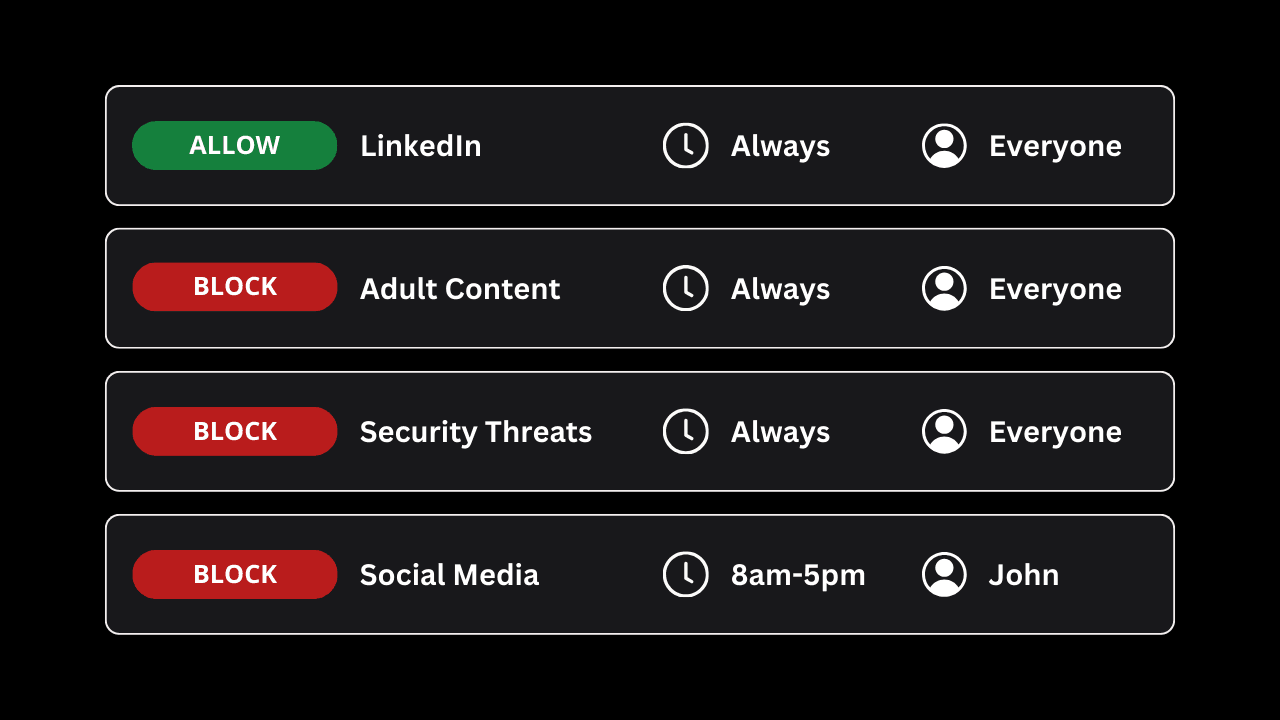Block Websites
Best Methods for Blocking Websites in 2024
Effectively block websites on computers and smartphones. Prevent users from bypassing website blocks.

As a software developer, I've experienced how blocking websites can help rewire bad habits caused by internet use. If you're managing a household, effective website blocking gives you some peace of mind that family members aren't stumbling on traumatic online material. In 2024, blocking websites isn't just a parental control concern anymore - adults want to set up guardrails around their own internet use as well. In this guide, I'll break down the most effective ways to block websites and my recommended approach given the common use-cases I've seen from my customers.
If you are trying to block porn , you should combine several of these layers together for a more effective website blocking system.
Block Websites Based on DNS Category
The first website blocking layer you should configure is DNS category blocking. You can quickly block thousands or even millions of websites based on how they are classified by these DNS services.
Blocking based on DNS category is compatible with almost any device that can use the internet.
For example, using the Tech Lockdown DNS Content Policy , you can create website block rules and select from hundreds of DNS categories.
When editing a rule, you can choose a DNS category to quickly block millions of similar websites.
Restrict Access to Domains that use Disallowed Keywords
Similar to blocking based on category, blocking websites based on a keyword is another comprehensive way to block millions of websites based on the words that those websites use in the domain name.
This blocking technique adds a bit more flexibility compared to category-based blocking.
For example, if you want to block websites that talk about a certain fast-food restaurant without restricting access to other similarly categorized websites, you could specify disallowed keywords in your Content Policy .
You can use the same DNS Content Policy where you specified disallowed categories to also specify disallowed keywords in the website domain name.
I'd recommend combining the keyword blocking approach with DNS Category blocking. Keywords provide extra flexibility, but category-based blocking will solve for more use-cases.
Restrict Accessing Unreviewed Websites
One of my favorite website blocking approaches is the default-deny blocking approach where only whitelisted websites and apps can be visited and everything else is blocked.
The most common use-case for this is dealing with unknown social media websites that could display a mix of content. Instead of having to figure out every possible harmful social media website that should be blocked, you can use the opposite approach. Here's how it works:
Using a DNS Content Policy , you could create a block rule for the Social Networking DNS Category. This would block all social networking websites and apps. Then, you would create an Allow rule to whitelist the social networking websites that you've approved.
The Social Media rule blocks most social media websites, such as Facebook, Instagram, or TikTok. However, the LinkedIn rule makes a specific exception, so devices connected to your Content Policy can still access that website.
This approach is ideal for parents who can't possibly keep up with every new social media platform. You should block all social media apps by default and selectively whitelist the safe social media apps. Add a schedule for good measure!
Schedule when Certain Websites are Blocked
One of the core parts of any website blocking system is the ability to schedule access to certain websites. I personally use this to limit when I can access social networking to break the habit of compulsively checking social media.
When configuring a DNS Content Policy , you can assign a schedule to any of the rules you create to specify when the rule is active. For example, I've created a block rule to restrict accessing social media late at night:

Limiting Explicit Online Searches
Another area to consider when blocking websites is to prevent the discovery of explicit websites and content by filtering what can be searched for on Google, bing, and other search engines.
Keep in mind that if you are blocking websites, these blocked websites still might display in Google's search results. However, when the webpage is clicked from the search engine results page, the user won't be able to load the website.
Despite this, it's still useful to limit what can be discovered by searching online. The first way to do this is to enforce SafeSearch on search engines like Google to automatically filter out explicit and harmful content. This also limits Google image search, which is why we recommend enforcing SafeSearch even when blocking DNS categories.
It's possible to force SafeSearch the following ways:
- Using the SafeSearch rule in your DNS Content Policy .
- Toggling on certain device and browser settings. These settings can also be protected to prevent a user from undoing them. More information in the device-specific guides below.
Protecting device and browser SafeSearch settings for each device:
Restricting Pages Within a Website or App
Some websites have a DNS category of Social Networking but you might discover sections of the website that you'd rather not have access to. For example, YouTube is classified as "Video Streaming," but many people want to
block access to YouTube shorts
.
You'll need to use a more nuanced approach if you want to filter content within a website or app and the implementation details varies depending on the device you are using.
Reference the guides below for examples of how to do this:

Frequently Asked Questions
What are the best ways to Block Websites on Windows, Mac, Android, and iOS?
There are a few distinct website blocking techniques that depend on the type of device you are using. A DNS Content Policy works on all types of computers and smartphones. However, there are also additional website blocking techniques for each type of device. We recommend implementing several website blocking layer for better bypass prevention and improved blocking customization. Reference our device-specific guides below:
Preventing Website Blocking from being Bypassed
The main goal at Tech Lockdown is to help people protect themselves or others from the harmful aspects of the internet. If you are trying to simultaneously block addictive or harmful websites while also protecting your devices from security threats, you have an even tougher battle.
Most people aren't motivated to bypass their own virus scanner or privacy tool. But if you are also blocking addicting content, people will go through great lengths to bypass website blocking. This is a difficult combination of incentives.
This is why I've gone through so much effort to help people prevent bypass of the most effective website blocking techniques. You want to avoid situations where your protective Firewall is unintentionally or intentionally bypassed.
We cover many of these concepts in our free guides, but you'll get a more streamlined approach by becoming a Tech Lockdown member and setting up the Tech Lockdown blocking and bypass prevention system:
- Protect settings in order to prevent website blocking from being bypassed
- Increase accountability and browsing transparency
- Preventing uninstall of apps and browsers extensions
- Handling common bypass methods
